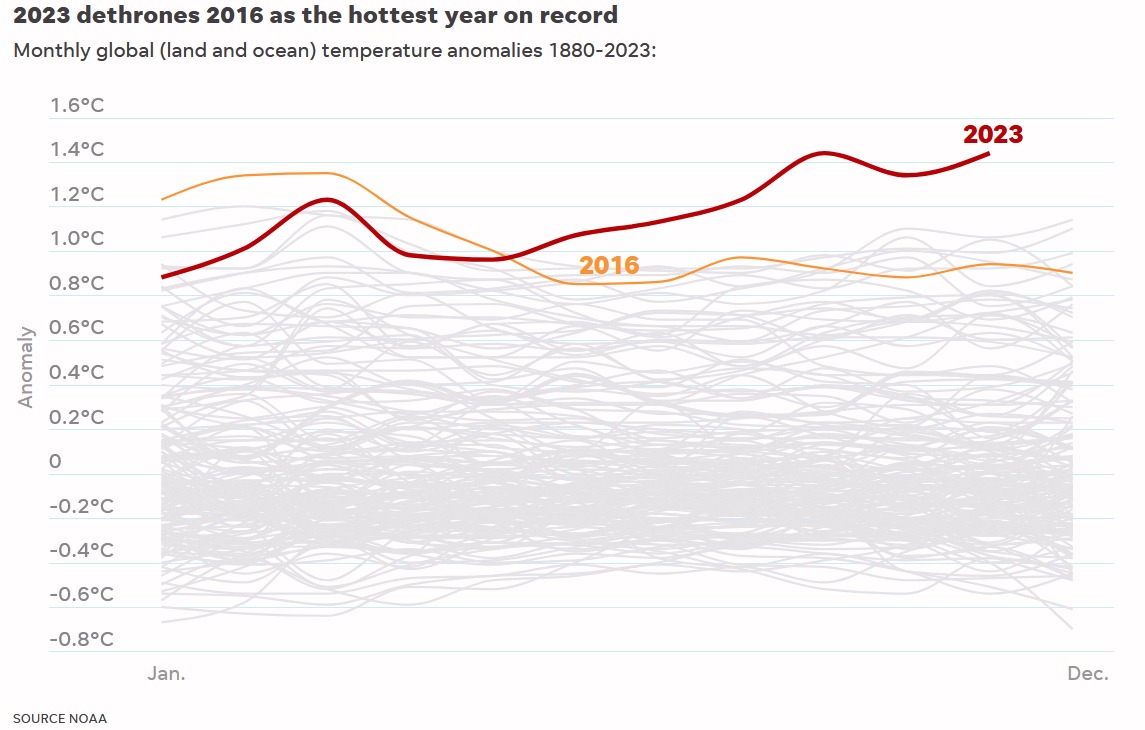
About the Age of Loss and Damage
Climate change is primarily driven by the escalation of thermal energy affecting biogeophysical and socio-economic systems. While biogeophysical factors can be studied using math, physics, and historical records, socio-economic systems pose greater challenges due to the unintended consequences of human behavior and inexplicable consumer choices.
Human induced climate change is an exponential component of an unordered system (chaos theory). That means global warming is accelerating at a rapid rate in a complex way.
Unfortunately, even scientists are failing to see (let alone forecast) the rapid acceleration in climate change. Due to their complexity, the impacts of the Domino Effect are being underestimated. Tipping points are Critical Milestones that directly impact the rate of acceleration in climate change by multiplying the number and intensity of feedback loops. The Domino Effect is also known as "tipping cascades" in climate science. Cascading impacts in relation to tipping points include cascading impacts across biogeophysical and social systems. Until recently, scientist have been drastically underestimating the social-ecological systems. The University of Exeter reports, "There is a notable lack of topic clusters dedicated to how humans will be impacted by climate-related tipping cascades."
Regrettably, the United States ranks among the least prepared countries globally, with the highest percentage of climate deniers. Politicians exacerbate the problem by hindering efforts against climate change. The Republican Party dismisses it as a manufactured crisis and plans to increase fossil fuel production. Political extremists asserting that the climate crisis is manufactured employ an ironic term, considering that human manufacturing activities are the primary driver of climate change.
Under President Biden, the United States continues to be the world's largest producer of oil, including crude oil, natural gas liquids, and other petroleum products. Both political parties have concurred to allocate unlimited emergency funding for climate disasters instead of proactively preventing them. In 2023, the U.S. witnessed a record number of climate disasters exceeding one billion dollars each, totaling 28 separate weather and climate-related events.
In June 2024, the Supreme Court significantly increased its authority and stripped the EPA of the ability to enforce environmental protection laws. This arrogance and ignorance mean that "worst-case scenarios" are now "best-case scenarios" for the acceleration of climate change. These factors have altered our climate model, shifting the projected maximum temperature rise from 4°C over the next millennium to a probable increase of 9°C this century. A 9°C increase would bring the Earth close to a wet-bulb temperature incapable of sustaining human life.
The Age of Loss and Damage is a new way of thinking about economics by combining economics, climate science, statistics, and physics. Until now, economic models have been unfit to capture the full extent of climate damage. Traditionally, "integrated assessment models" (IAMs) were used to forecast "shock" events. IAMs use "quadratic function" to calculate GDP losses by squaring the temperature change, yet ignore other methods (such as the exponential function) that are better suited for rapid change. "Climate change is fundamentally different to other shocks because once it has hit, it doesn't go away," said Thierry Philipponnat, author of a report by Finance Watch, a Brussels-based public interest NGO on financial issues. "And if the fundamental assumption is flawed, all the rest makes little sense -- if any."
Reuters reported, "Critics say this (IAMs) choice is doomed to underplay the likely impact - particularly if the planet hits environmental tipping points in which damage is not only irreversible but happens at an ever-accelerating rate." Thierry Philipponnat's report, Finance in a Hot House World, concludes: "Climate risk is growing to disruptive levels throughout the financial system and the guardians of financial stability urgently need to adapt their tools to regain control." The report calls for economic models that do not mislead, scenario analyses that prepare the market, and a new prudential tool to address the build-up of systemic climate risk.
Traditional economics is based upon the "costs and benefits" to society. Since there are no known long-term benefits of climate change to society, the Age of Loss and Damage economics focuses on the exponential costs of climate change to society.
2023: The Hottest Year in Human History
2023 was a wake-up call to both biogeophysical and social-ecological scientists. The record breaking physical and economical impacts could be felt worldwide. The record warming year was seventeen times greater than any other record increase in history. Typically record breaking temperatures are measured in 100th degrees. There were also 200 consecutive days of record breaking temperatures. Typically there are one or two record breaking days in row.
The graphic shows how far out of skew the 2023 anomalies are compared to the previous record set in 2016.
The increase in intensity and frequency of record breaking heat requires forecasting models to be recast.
In 2023, the U.S. experienced 28 separate weather and climate disasters costing at least 1 billion dollars. That number puts 2023 into first place for the highest number of billion-dollar disasters in a calendar year and included:
2023 was also deadly, causing at least 492 direct or indirect fatalities -- the 8th most disaster-related fatalities for the contiguous U.S. since 1980.
* Our climate model employs chaos theory to comprehensively consider human impacts and projects a potential global average temperature increase of 9 degrees Celsius above pre-industrial levels.
What Can I Do?
There are numerous actions you can take to contribute to saving the planet. Each person bears the responsibility to minimize pollution, discontinue the use of fossil fuels, reduce consumption, and foster a culture of love and care. Be a butterfly and affect the world.
The Butterfly Effect illustrates that a small change in one area can lead to significant alterations in conditions anywhere on the globe. Hence, the frequently heard statement that a butterfly in China can cause a hurricane in the Atlantic.
Here is a list of additional actions you can take.
Climate Change: Rate of Acceleration
Climate Change: How Long Is "Ever"?